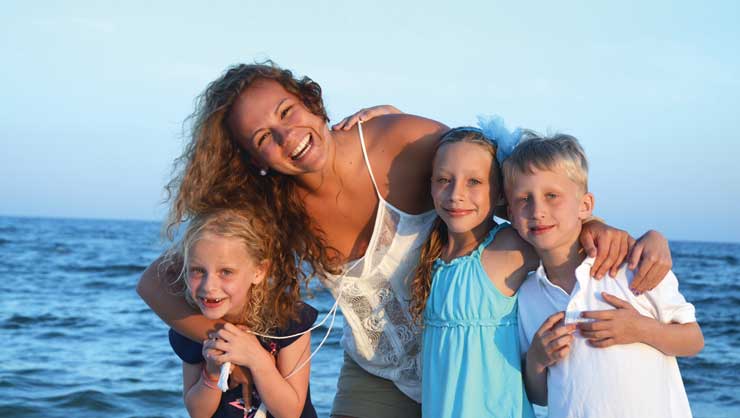The U.S. is a very diverse country, so it makes sense that parenting styles would also portray lots of diversity. When you’re an au pair on a cultural exchange program, it’s important to understand and respect your host family’s methods and honor their values. Caring for your host children may look different than how you’ve cared for children in your home country.
While there are many different approaches to parenting, here are five popular methods you may encounter as an au pair during your program year. Keep in mind, your host family may practice some aspects from more than one parenting style as well.

1. Authoritative Parenting
Authoritative parenting balances rules and warmth. It was first defined and developed by developmental psychologist Diane Baumrind. Parents use positive reinforcement and reasoning to guide children and avoid threats or punishments. Setting clear expectations and guidelines and explaining the reasoning behind disciplinary actions reinforces authoritative parenting. For example, parents may set a bedtime for the child while being open to hearing the child’s feelings and requests to stay up longer, possibly compromising with an extra few minutes of reading time before bed. As an au pair, it’s your role in an authoritative parenting home to follow and guide via rules, while honoring the family values of openness and compromise.
2. Authoritarian Parenting
Although the names sound similar, authoritarian parenting is quite different from authoritative parenting. Authoritarian parenting is a very structured and rule-based approach. There are clear expectations, and boundaries are enforced more often than not. Basically, there is less room for rule bending. This parenting style will often use punishment, like taking away privileges; however, physical discipline of a child as an act of punishment is never acceptable. The focus of authoritarian parenting is obedience. In an authoritarian home, parents will often make decisions without input from the children.
3. Permissive Parenting
Permissive parenting includes a lot of nurturing and not a lot of limitations. Permissive parents don’t present themselves as authoritarian figures for their children. There is often a relaxed take on structure and boundaries in a permissive parenting household. Discipline may often be avoided. For example, in permissive parenting situations, it may be more common to give into a child’s requests or let children make their own choices. Permissive parenting tends to avoid saying, “No” to the child, even in situations when it may be more common in other parenting styles to set boundaries or limits.
4. Conscious Parenting
Conscious parenting encourages self-awareness on the parent or caregiver side. Before reacting to a child’s behavior, examining your own thoughts, feelings, and motivations and understanding how those might be influencing how you feel is an important part of conscious parenting. Conscious parenting is all about being intentional. For example, if your child won’t listen to the rules about screen time and you’ve had to take away their tablet, they may be visibly upset or angry. Speaking to them calmly, asking how they’re feeling, and explaining how you’re feeling is a way to consciously parent in that situation.
5. Montessori Parenting
Montessori parenting, similar to Montessori style teaching, is focused on child-led learning and independence. Montessori in parenting focuses on parents as guides rather than leaders, allowing children to make choices, solve problems, and take responsibility for their actions. Practical life skills are of high importance when it comes to parenting the Montessori way. Children as young as two years old are encouraged to learn how to dress themselves, gather their belongings, help prepare foods, and more.
Hybrid Approaches
Chances are your host family does not parent in one way only, all the time. Sometimes, one parent leans more towards one method vs. the other. Sometimes different children’s personalities require different parenting styles within the same home. Be prepared for your host parents to not fit one type of parenting style and understand, more often than not, a combination of two or more or a hybrid approach may be more realistic and effective in parenting. Asking questions, learning about different styles and American culture overall through observation, and communicating often and effectively are the best ways to ensure you’re aligning with your host family’s parenting values and style.
Whatever parenting style your host family has, even if it’s quite different from how you were raised or how most families parent in your home country, remember that being an au pair is about open-mindedness and cultural exchange. Be curious and respectful about your host family’s values and parenting choices. As their au pair, you’ll want to fit into their approach when it comes to caring for their children.
If you’re ready to find your American host family, learn about becoming an au pair with Au Pair USA! For over 35 years, we’ve been successfully matching and supporting au pairs with American host families. We’d love to support you too!



